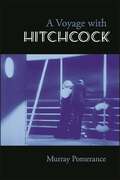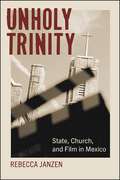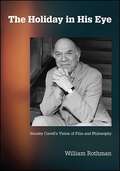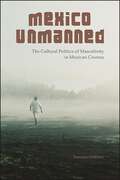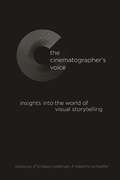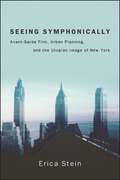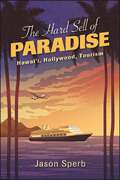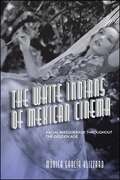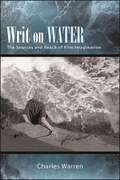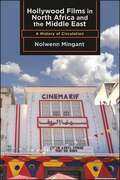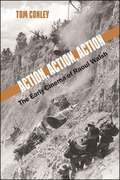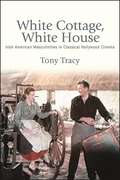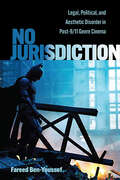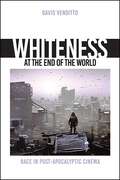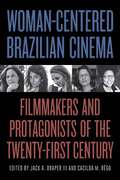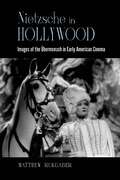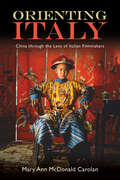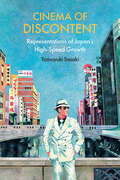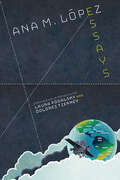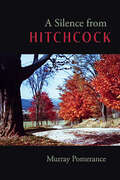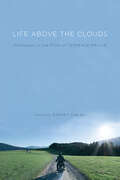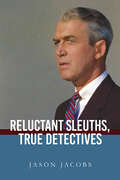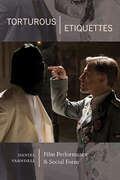- Table View
- List View
A Voyage with Hitchcock
by Murray PomeranceFollowing from An Eye for Hitchcock and A Dream for Hitchcock, this third volume of reflections upon Alfred Hitchcock's work gives extensive meditations on six films: Psycho, The 39 Steps, The Birds, Dial M for Murder, Rich and Strange, and Suspicion. Murray Pomerance's sources come from a wide territory of interest, including production study, philosophy, cultural history, and more. The book is written as an homage to, and in many ways address to, not only the story content of these films but, more importantly, their overall filmic texture, which involves compositions, visual nuances, sounds, rhythms, and Hitchcock's unique treatments of human experience. The voyage theme plays a key—and moving—role in all the films discussed here.
Unholy Trinity: State, Church, and Film in Mexico (SUNY series in Latin American Cinema)
by Rebecca JanzenRebecca Janzen brings a unique applied understanding of religion to bear on analysis of Mexican cinema from the Golden Age of the 1930s onward. Unholy Trinity first examines canonical films like Emilio Fernández's María Candelaria and Río Escondido that mythologize Mexico's past, suggesting that religious imagery and symbols are used to negotiate the place of religion in a modernizing society. It next studies films of the 1970s, which use motifs of corruption and illicit sexuality to critique both church and state. Finally, an examination of films from the 1990s and 2000s, including Guita Schyfter's Novia que te vea, a film that portrays Mexico City's Ashkenazi and Sephardic Jewish communities in the twentieth century, and Carlos Carrera's controversial 2002 film El crimen del padre Amaro, argues that religious imagery—related to the Catholic Church, people's interpretations of Catholicism, and representations of Jewish communities in Mexico—allows the films to critically engage with Mexican politics, identity, and social issues.
The Holiday in His Eye: Stanley Cavell's Vision of Film and Philosophy (SUNY series, Horizons of Cinema)
by William RothmanFrom The World Viewed to Cities of Words, writing about movies was strand over strand with Stanley Cavell's philosophical work. Cavell was one of the first philosophers in the United States to make film a significant focus of his thought, and William Rothman has long been one of his most astute readers. The Holiday in His Eye collects Rothman's writings about Cavell—many of them previously unpublished—to offer a lucid, serious introduction to and overview of Cavell's work, the influence of which has been somewhat limited by both the intrinsic difficulty of his ideas and his challenging prose style. In these engaging and accessible yet philosophically serious and rigorously argued essays, Rothman presents an original, insightful, and compelling vision of the trajectory of Cavell's oeuvre, one that takes Cavell's kinship with Emerson as inextricably bound up with his ever-deepening thinking about movies.
Mexico Unmanned: The Cultural Politics of Masculinity in Mexican Cinema (SUNY series in Latin American Cinema)
by Samanta OrdóñezIconic images of machismo in Mexico's classic cinema affirm the national film industry's historical alignment with the patriarchal ideology intrinsic to the post-revolutionary state's political culture. Filmmakers gradually turned away from the cultural nationalism of mexicanidad, but has the underlying gender paradigm been similarly abandoned? Films made in the past two decades clearly reflect transformations instituted by a neoliberal regime of cultural politics, yet significant elements of macho mythology continue to be rearticulated. Mexico Unmanned examines these structural continuities in recent commercial and auteur films directed by Alfonso Cuarón, Carlos Cuarón, Carlos Reygadas, Amat Escalante, and Julio Hernández Cordón, among others. Informed by cinema's role in Mexico's modern/colonial gender system, Samanta Ordóñez draws out recurrent patterns of signification that reproduce racialized categories of masculinity and bolster a larger network of social hierarchies. In so doing, Ordóñez dialogues with current intersectional gender theory, fresh scholarship on violence in the neoliberal state, and the latest research on Mexican cinema.
The Cinematographer's Voice: Insights into the World of Visual Storytelling (SUNY series, Horizons of Cinema)
by Lindsay Coleman; Roberto SchaeferThe Cinematographer's Voice is a unique exploration of contemporary filmmaking and cinematography. The distillation of more than one-hundred interviews with cinematographers from around the world, and the product of a decade's worth of scholarship, the book is not only a collection of interviews with some of the world's leading cinematographers, but also a panoramic sweep of what image-making means in the era of digital cinema. Frequently, cinematography may seem intimidating as a discipline, the preserve solely of practitioners who have learned, through years of exposure to photographic technology, both the required jargon and background knowledge to comfortably engage with an often-technical field. In our present era of film studies, this is no longer the case. The interviews collected here are informative not only on matters of technique, but also on the ways in which practitioners formulate their methodologies, work with directors, and engage with the many logistical hurdles of visual storytelling. The result is an oral history of the past forty years of filmmaking and the cinematography it has produced.
Seeing Symphonically: Avant-Garde Film, Urban Planning, and the Utopian Image of New York (SUNY series, Horizons of Cinema)
by Erica SteinCan the cinema imagine a different way of developing, using, and living in the city? Is it possible to do so using images of the extant city? Seeing Symphonically shows how a group of independent experimental, documentary, and feature films made in and about late modern New York City did just this. Between 1939 and 1964, as the city was being utterly remade by a combination of urban renewal projects, suburbanization, and high-rise public housing, the New York avant-garde reinvented the city symphony, a modernist form that depicted a day in the life of an urban environment through complex montage, optical effects, and street portraiture. Erica Stein documents how these New York City symphonies subverted and critiqued urban redevelopment through their aesthetics, particularly their rhythms, and, through those same rhythms, envisioned a world in which urban inhabitants have the absolute right to remake the city according to their needs, outside the demands of capital.
Screening #MeToo: Rape Culture in Hollywood
by Lisa Funnell Ralph BeliveauScreening #MeToo offers an important and timely discussion of the pervasive nature of rape culture in Hollywood. Essays in the collection examine films released from the 1960s onward, a broad period that coincides with the end of the Motion Picture Production Code in Hollywood, which resulted in more frequent and increasingly graphic images of sex and violence being included in mainstream movies. Focusing on narratives in which surveillance and sexual violence feature prominently, contributors from North America and Europe examine a variety of film genres, including spy films, teen comedies, kitchen sink dramas, coming-of-age stories, rape/revenge films, and horror films. Reflecting the increasing social and academic awareness of sexual violence in Hollywood film and its transmission and cultivation of rape culture in the United States and abroad, they are concerned not only with the content of the films under scrutiny but also with the clear relationship between the stories, how they are being told, and the culture that produced them. Screening #MeToo challenges readers to look at mainstream Hollywood films differently, in light of attitudes about art and power, sexuality and consent, and the pleasures and frustrations of criticizing "entertainment" films from these perspectives.
The Hard Sell of Paradise: Hawai'i, Hollywood, Tourism (SUNY series, Horizons of Cinema)
by Jason SperbThe Hard Sell of Paradise examines how mid-twentieth-century Hollywood, negotiating the rhetoric of the tourism industry, offered a complex and contradictory vision of "Hawai'i" for its audiences. From the classic studio system and elite tourism of the 1930s to a postwar era of mass travel, TV, and new leisure markets, the book explores how an eclectic group of populist media reflected the language of tourism not only through its narratives of leisure, but also through its complex engagement with larger cultural and historical questions, such as colonialism, world war, and statehood. Drawing on rare archival research, The Hard Sell of Paradise also explores the valuable role that tourism partners such as United Airlines, Matson Cruise Lines, and the Hawaii Tourist Bureau played in directly and indirectly influencing such films and television shows as Waikiki Wedding, Diamond Head, Blue Hawaii, The Endless Summer, and Hawaii Five-O.
The White Indians of Mexican Cinema: Racial Masquerade throughout the Golden Age (SUNY series in Latin American Cinema)
by Mónica García BlizzardThe White Indians of Mexican Cinema theorizes the development of a unique form of racial masquerade—the representation of Whiteness as Indigeneity—during the Golden Age of Mexican cinema, from the 1930s to the 1950s. Adopting a broad decolonial perspective while remaining grounded in the history of local racial categories, Mónica García Blizzard argues that this trope works to reconcile two divergent discourses about race in postrevolutionary Mexico: the government-sponsored celebration of Indigeneity and mestizaje (or the process of interracial and intercultural mixing), on the one hand, and the idealization of Whiteness, on the other. Close readings of twenty films and primary source material illustrate how Mexican cinema has mediated race, especially in relation to gender, in ways that project national specificity, but also reproduce racist tendencies with respect to beauty, desire, and protagonism that survive to this day. This sweeping survey illuminates how Golden Age films produced diverse, even contradictory messages about the place of Indigeneity in the national culture.This book is freely available in an open access edition thanks to TOME (Toward an Open Monograph Ecosystem)—a collaboration of the Association of American Universities, the Association of University Presses, and the Association of Research Libraries—and the generous support of Emory University and the Andrew W. Mellon Foundation. Learn more at the TOME website, available at: https://www.openmonographs.org/. It can also be found in the SUNY Open Access Repository at http://hdl.handle.net/20.500.12648/7153
Writ on Water: The Sources and Reach of Film Imagination (SUNY series, Horizons of Cinema)
by Charles WarrenThis eloquent book draws on the author's responses to a wide range of extraordinary films—"long takes" on Altman's Nashville, Godard's Hail Mary, Makavejev's WR: Mysteries of the Organism, and von Sternberg's Blonde Venus, as well as "short takes" on films by Jean Rouch, Chris Marker, Chantal Akerman, Ross McElwee, Michelangelo Antonioni, Michael Haneke, and Jean-Pierre and Luc Dardenne. Charles Warren's masterful close readings blend profound philosophical reflections with a treasure trove of literary and artistic references to place film, in its relations to other arts, as one of the greatest aesthetic forms. Collectively, these essays offer an original and powerful statement on the nature of film and the intimate relation of what the author calls "film imagination" to our lives as human beings in the world. This important and much-needed book is no less than a celebration and affirmation of the very discipline of film criticism. One is left with one's appetite for film refreshed.
Hollywood Films in North Africa and the Middle East: A History of Circulation (SUNY series, Horizons of Cinema)
by Nolwenn MingantDrawing on a broad range of primary sources, from trade and government publications to interviews, Hollywood Films in North Africa and the Middle East traces the circulation of Hollywood films across the region from the early twentieth century to the present. Originally introduced by French distributors, Hollywood films have been a key component of film culture in North Africa and the Middle East. These films became a favored mode of entertainment during the first half of the century as the major US film studios built a strong distribution structure. After World War II, the changing geopolitical context of decolonization pushed US distributors out of the market. Hollywood films, however, have continued to be favored by audiences. Today, in a landscape that also includes Egyptian and Indian films, Hollywood remains a relevant force in the region’s film culture, experienced by audiences in myriad ways from the pirate markets of North Africa to state-of-the-art theatres in the United Arab Emirates.
Action, Action, Action: The Early Cinema of Raoul Walsh (SUNY series, Horizons of Cinema)
by Tom ConleyDirector of over 150 films from 1912 to 1964, Raoul Walsh was a core figure in Hollywood from its beginnings to the end of the studio system. Perhaps best known for such films as The Big Trail (starring John Wayne in his first leading role), High Sierra, and White Heat, Walsh cut his teeth under D. W. Griffith, and, like his contemporary John Ford, found a style and signature in his silent cinema and early talkies. Through close analysis of seven of his films, six shot between 1915 and 1933 and one a remake from 1956, and stressing the visual character of their settings and situations, Tom Conley examines how composition and montage—or action—often overtake the crisp narratives these films convey. Rife with contradiction, they ask us to see what makes them possible and how they contend with prevailing codes. Films discussed include Regeneration (1915); Sadie Thompson (1928) and a likely avatar, The Revolt of Mamie Stover (1956); The Cock-Eyed World (1929); The Big Trail (1930); Me and My Gal (1932); and The Bowery (1933).
White Cottage, White House: Irish American Masculinities in Classical Hollywood Cinema (SUNY series, Horizons of Cinema)
by Tony TracyWhite Cottage, White House examines how Classical Hollywood cinema developed and deployed Irish American masculinities to negotiate, consolidate, and reinforce hegemonic whiteness in midcentury America. Largely confined to discriminatory stereotypes during the silent era, Irish American male characters emerge as a favored identity with the introduction of sound, positioned in a variety of roles as mediators between the marginal and mainstream. The book argues that such characters function to express hegemonic whiteness as ethnicity, a socio-racial framing that kept immigrant origins and normative American values in productive tension. It traces key Irish American male types—the gangster, the priest, the cop, the sports hero, and the returning immigrant—who navigated these tensions in maintenance of an ethnic whiteness that was nonetheless "at home" in America, transforming from James Cagney's "public enemy" to John Wayne's "quiet man" in the process. Whether as figures of Depression-era social disruption, avatars of presidential patriarchy and national manhood, or allegories of postwar white flight and the nuclear family, Irish American masculinities occupied a distinctive and unrivaled visibility and role in popular American film.
No Jurisdiction: Legal, Political, and Aesthetic Disorder in Post-9/11 Genre Cinema (SUNY series, Horizons of Cinema)
by Fareed Ben-YoussefNo Jurisdiction interweaves autobiography and analysis to explore how a disabled American of French-Arab descent justifies his love for the (super)heroes who destroy brown people like himself. Framing Hollywood genre films as a key to understanding a crisis-filled world shaped by the global War on Terror, Fareed Ben-Youssef shows how, in response to 9/11, filmmakers and lawmakers mobilized iconic characters—the cowboy, the femme fatale, and the superhero—to make sense of our traumas and inspire new legal landscapes. The competing visions of power produced in this dialogue between Hollywood entertainment and mainstream politics underscore genre cinema's multivalent purpose: to normalize state violence and also to critique it.Chapters devoted to the Western, film noir, superhero movies, and global films that deploy and comment on these genres offer compelling readings of films ranging from the more apparent (The Dark Knight, Sicario, and Logan) to the more unexpected (Sin City, Adieu Gary, The Broken Circle Breakdown, and Tokyo Sonata). Through narratives of states of emergency that include vaguely defined enemies, obscured battlefield boundaries, and blurred lines between victims and perpetrators, a new post-9/11 film canon emerges. No Jurisdiction is a deeply personal work of film scholarship, arguing that we can face our complicity and discover opportunities for resistance through our beloved genre movies.
Whiteness at the End of the World: Race in Post-Apocalyptic Cinema (SUNY series, Horizons of Cinema)
by David VendittoThe use of Christian apocalyptic myths has changed significantly over the centuries. Initially used by genuinely disenfranchised groups, they are used today as a response to more egalitarian treatment of minorities in American society. The apocalyptic framework allows the patriarchy to frame itself as the victim who must restore America to a past where white male power went uncontested. This kind of white anxiety over increasing minority rights frequently manifests itself in contemporary apocalyptic media, which often depicts a white male hero facing a wide array of threatening "Others." Taking a unique look at the parallels between apocalypticism and American frontier mythology, as well as conspiracy theories and the post-apocalyptic obsession with repurposed objects, Whiteness at the End of the World analyzes many well-known films from the past fifty years, from Planet of the Apes to I Am Mother. It offers unique, clearly presented insights into recurring patterns that appear in an extraordinarily ubiquitous genre that has only increased in popularity, and whose themes of racial anxiety are increasingly pertinent in our increasingly contentious political climate.
Woman-Centered Brazilian Cinema: Filmmakers and Protagonists of the Twenty-First Century (SUNY series in Latin American Cinema)
by Jack A. Draper III Cacilda M. RêgoWoman-Centered Brazilian Cinema highlights the bold, inspiring, and diverse work of female filmmakers—including directors, screenwriters, and producers—and female protagonists in the twenty-first-century Brazilian film industry. This volume examines the diverse production and distribution spaces these filmmakers are working in, including documentary, experimental, and short filmmaking, as well as commercial feature films. An intersectional approach runs throughout the chapters with complex considerations around gender, race, sexuality, and class. The book features a mix of research methods and genres, with macro-level political, economic, and industry-wide views of gender disparities appearing alongside in-depth conversations with contemporary filmmakers Maria Augusta Ramos, Petra Costa, Mari Corrêa, and Paula Sacchetta, focused on micro-level personal experiences. In bringing together original essays and interviews, the volume provides valuable information for students of Brazil in general and of Brazilian film in particular.
Nietzsche in Hollywood: Images of the Übermensch in Early American Cinema (SUNY series, Horizons of Cinema)
by Matthew RukgaberNietzsche in Hollywood offers a compelling and startling history of Hollywood film in which the German philosopher Friedrich Nietzsche and his idea of the Übermensch looms large. Though Nietzsche's philosophy was attacked as egoistic and a sociopathic version of Darwinism in films from the 1910s, it undergoes a series of cinematic and philosophical transformations in the 1920s and 1930s under the eye and pen of some of the most significant names in early Hollywood, including Erich von Stroheim, Josef von Sternberg, Ben Hecht, Howard Hawks, and Ernst Lubitsch. In addition to establishing historical connections between Nietzsche's philosophy and these filmmakers, the book provides philosophical readings of many Hollywood films through the lens of the Nietzschean ideas of "perspectivism" and the critique of morality. Offering a new history of classic Hollywood films as well as a new approach to film philosophy, Nietzsche in Hollywood reveals a reading of the philosopher in American culture that has largely been ignored.
Orienting Italy: China through the Lens of Italian Filmmakers (SUNY series, Horizons of Cinema)
by Mary Ann McDonald CarolanWinner of the 2022 Book Award for Performance and Visual Culture presented by the American Association of Teachers of ItalianOrienting Italy explores contemporary Italian filmmakers' fascination with China and the Chinese in both documentary and fictional films. Delineating the contours of this fascination, the book begins with the works of Carlo Lizzani (Behind the Great Wall, 1958) and Michelangelo Antonioni (Chung Kuo—China, 1972), both of whom ventured to China with the aim of documenting new, yet physically and culturally distant, realities. Their documentary investigations yielded to fictional portrayals, from the lavish view of a historical Middle Kingdom by director Bernardo Bertolucci (The Last Emperor, 1987) to the stark consideration of Italian economic exchange with contemporary China by Gianni Amelio (The Missing Star, 2006). The wave of Chinese migration to Italy in the late twentieth century created a new sense of otherness within Italy as Chinese migrants became the subjects of fictional narratives and documentaries in the works of Stefano Incerti (Gorbaciof, 2010) and Andrea Segre (Shun Li and the Poet, 2011) and Riccardo Cremona and Vincenzo De Cecco (Miss Little China, 2009). In the twenty-first century, a new chapter in the relationship between Italy and China has emerged in the form of transnational collaborations in the art and business of filmmaking.
Cinema of Discontent: Representations of Japan's High-Speed Growth (SUNY series, Horizons of Cinema)
by Tomoyuki SasakiFrom the mid-1950s to the mid-1970s, Japan experienced an unprecedented level of economic growth, transforming itself from a war-devastated country to a global economic power. Our image of postwar Japan has been shaped by this event, and we tend to see its history as a story of great national success. Cinema of Discontent challenges this view and details the tensions generated by massive and intense capitalist development through analyses of popular cinema produced during the era of high-speed growth. The films discussed in this book, directed by Kawashima Yūzō, Masumura Yasuzō, Inoue Akira, Ezaki Mio, and Kumashiro Tatsumi, attracted broad audiences yet remain understudied. Cinema of Discontent contextualizes these films in relation to the politics, economy, intellectual discourse, and cultural texts of the time. By doing so, it demonstrates how these films address problems immanent to Japan's postwar capitalism, including uneven development, increasing corporate control over individuals, precarious and contingent work, and militarized peace and prosperity.
Ana M. López: Essays (SUNY series in Latin American Cinema)
by Ana M LópezAna M. López is one of the foremost film and media scholars in the world. Her work has addressed Latin American filmmaking in every historical period, across countries and genres—from early cinema to the present; from Brazil, Cuba, and Mexico to diasporic and Latinx cinemas in the United States; from documentary to melodrama to politically militant film. López's groundbreaking essays have transformed Latin American film studies, opening up new approaches, theoretical frameworks, and lines of investigation while also extending beyond cinema to analyze its connections with television, radio, and broader cultural phenomena. Bringing together twenty-five essays from throughout her career, including three that have been translated into English for this volume, Ana M. López is divided into three sections: the transnational turn in Latin American film studies; analysis of genre and modes; and debates surrounding race, ethnicity, and gender. Expertly curated and edited by Laura Podalsky and Dolores Tierney, the volume includes introductory material throughout to map and situate López's key interventions and to aid students and scholars less familiar with her work.
A Silence from Hitchcock
by Murray PomeranceIn A Silence from Hitchcock, Murray Pomerance explores the resonating power of silence in the director's work—its variation, its haunting temptation, and its technical power. Working from a meditative devotion to and an illuminating familiarity with the director's work, Pomerance shines light upon six films, some of them (Notorious, The Lady Vanishes, and The Trouble with Harry) frequently, even obsessively treated, and others (Frenzy, The Wrong Man, and Topaz) less often discussed. In its strange relation to speech, memory, urbanity, guilt, mortality, and espionage, silence becomes, in these films, a dramatic protagonist in its own right. Written by a master interpreter of Hitchcock, this book offers new ways of seeing, experiencing, and thinking about the films of one of cinema's greatest artists, as well as new ways of reflecting on our experience of cinema itself.
Distancing Representations in Transgender Film: Identification, Affect, and the Audience (SUNY series, Horizons of Cinema)
by Lucy J. MillerDistancing Representations in Transgender Film explores the representation of transgender identity in several important cinema genres: comedies, horror films, suspense thrillers, and dramas. In a critique that is both deeply personal and theoretically sophisticated, Lucy J. Miller examines how these representations are often narratively and visually constructed to prompt emotions of ridicule, fear, disgust, and sympathy from a cisgender audience. Created by and for cisgender people, these films do not accurately represent transgender people's experiences, and the emotions they inspire serve to distance cisgender audience members from the transgender people they encounter in their day-to-day lives. By helping to increase the distance between cisgender and transgender people, Miller argues, these films make it more difficult for cisgender people to understand the experiences of transgender people and for transgender people to fully participate in public life. The book concludes with suggestions for improving transgender representation in film.
Life Above the Clouds: Philosophy in the Films of Terrence Malick
by Steven DeLayLeaving a promising career in academic philosophy to embark on a career in film, American director Terrence Malick has created cinematic works of art that are also deeply philosophical. His contribution to philosophy through a half century of filmmaking has become the focus of increasing scholarly attention. Inviting the reader along a journey of reflections at the intersection of film, art, and philosophy, Life Above the Clouds brings together an international team of contributors to present the most current and definitive statement of the filmmaker's work. Accessibly written and exploring films such as Badlands, Days of Heaven, The Thin Red Line, The New World, The Tree of Life, To the Wonder, Knight of Cups, Song to Song, and A Hidden Life, the nineteen essays herein will be of interest not only to scholars and students of philosophy, theology, film studies, and aesthetics, but also to anyone with a true love of film.
Reluctant Sleuths, True Detectives (SUNY series, Horizons of Cinema)
by Jason JacobsReluctant Sleuths, True Detectives examines the detective figure in four noir and neo-noir films: Out of the Past (1947), Notorious (1946), Vertigo (1958), and Chinatown (1974). Exploring the way that these characters each move from an initial state of reluctant passivity to one of passionate engagement with the world around them, it questions the cinematic forces required to motivate and move them. In its close examinations of each film, the book meditates on the detectives' hunts and how they interact with the cinematic apparatus that captures and presents them to an audience, and it tracks the receptive experience of these films in relation to these questions of motivation and movement.
Torturous Etiquettes: Film Performance and Social Form (SUNY series, Horizons of Cinema)
by Daniel Varndell"Etiquette," as noted toastmaster Herbert V. Prochnow once pointed out, "is knowing how to yawn with your mouth closed"—that is, to spare the feelings of the other person, one must stifle one's own. To be polite, therefore, is to perform. Onscreen, closeups often reveal the effort that goes into maintaining that performance: with a fleeting frown or a slight scowl, an actor reveals the "torture" of mannered behavior. In Torturous Etiquettes, Daniel Varndell examines such gestures to reveal the difficulties of the social encounter. Drawing on the history of etiquette, the book deconstructs an array of examples from classical and contemporary Hollywood and European cinema, taking a close look at onscreen representations of rudeness, ridiculing, racist and sexist etiquettes, hospitality, table manners, and more. In doing so, it reveals etiquette to be a persistent theme in cinema and questions the role it plays in either upholding or denying the basic humanity of others.
